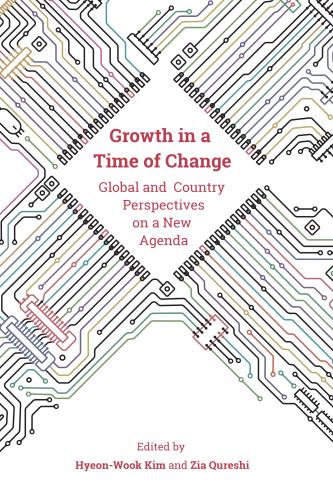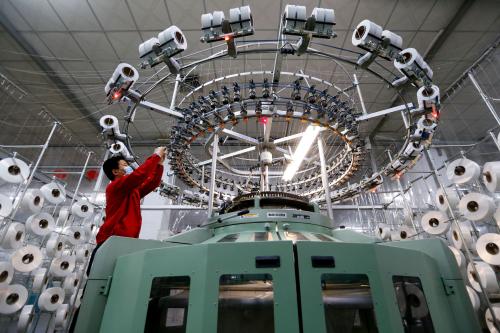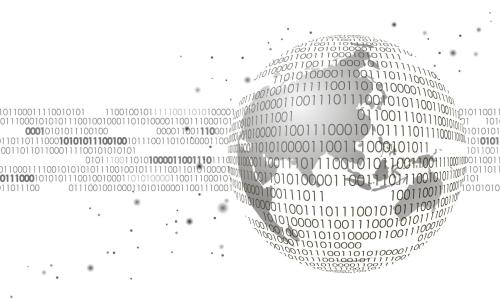This blog is part of a project exploring how the agenda for economic growth is being reshaped by forces of change, particularly technological change.
Globalization has entered a new phase, led by the increasing digitalization of international trade. Data flows are the conveyer belt of this transformation. New avenues for trade, innovation, and productivity growth are being created, but there are also risks. In my chapter in the just-published book “Growth in a Time of Change,” I examine the new opportunities and policy challenges.
Access and use of data can be a driver of trade, innovation, and productivity growth
Data are driving innovation, with opportunity for a new wave of productivity growth. Currently, approximately half of the world is online. Between 2005 and 2021, global internet traffic will increase 127fold. The rollout of the 5G network will support the ”internet of things” (IoT), such that by 2021, the number of devices connected to the internet will be triple the global population.
The ability to move data seamlessly and globally is supporting new business models, spurring research and development, facilitating international collaboration, and transforming international trade. Already, around 12 percent of global goods trade is via international e-commerce. E-commerce provides a potentially significant opportunity to increase small businesses’ participation in international trade, as having a website gives them an instant international presence, and e-commerce platforms provide embedded services such as financial payments and support with logistics. In Korea for instance, 100 percent of firms on eBay have cross-border sales, compared with 20 percent of offline firms.
Services are being increasingly traded online. This includes information technology (IT), professional, financial, retail, and education services. New digital services, such as cloud computing, have been developed and are becoming crucial business inputs.
Digital technologies are also being exported as part of traditional goods exports. For example, data collected from sensors on mining and farming equipment allow businesses to improve their operations and thereby the value from the use of such equipment.
Global data flows underpin global value chains (GVC), creating new opportunities for participation in international trade. The global internet and data flows enable businesses to plug into GVCs to offer their own specific service. Again, in the case of Korea for example, this is a particular opportunity for new and smaller Korean firms to participate in supply chains in Asia.
But restrictions on data flows are growing
As the opportunities presented by digital technologies grow, governments and regulators have to determine how to benefit from going digital while maintaining the integrity of their domestic regulations. Against this backdrop, there has been significant growth in data localization measures globally.
There are various forms of restrictions on data flows. They include measures that disallow the transfer of data outside national borders; measures that allow cross-border transfers but require a copy to be maintained domestically; and requirements of prior consent before data can be transferred overseas. Data localization measures often include restrictions on data flows.
Measures that restrict data flows and require data to be localized are implemented for a range of reasons. One reason, which is the case with privacy regulations, is to prevent data flows to jurisdictions with lower levels of privacy protection where this undermines domestic privacy protections. For example, the European Union’s General Data Protection Regulation, which came into effect in May 2018, prohibits businesses that collect personal data in the EU from transferring it outside the EU unless the receiving country has an equivalent level of privacy protection (personal data can also be transferred in a limited number of other circumstances).
Governments can also require data to be localized on the grounds that regulators need access to data in order to perform their regulatory functions. The most common of these is in the financial services sector, where data localization requirements are justified on the basis that financial regulators require financial data to remain local in case they need access to it for regulatory purposes. For instance, in 2018 India introduced a requirement that payment system operators store data locally in order to allow financial regulators to effectively perform their supervisory function.
Ensuring cybersecurity is another rationale for requiring data to be localized. The view here is that data localization decreases the risks of unauthorized access. Another reason for data flows restrictions is to control access to what content can be accessed online, usually on moral, religious or political grounds. For example, Iran’s censorship aimed at creating the ”Halal Internet” limits access to content deemed offensive to Islam. China blocks access to 11 of the top 25 global sites among an estimated 3,000 prohibited foreign websites.
Data localization measures are also being enacted for protectionist reasons. China’s blocking or degrading of internet access has supported the development of local champions. For instance, blocking access to Google and Facebook has been to the benefit of Baidu, Renren, and Sina Weibo.
The WTO includes commitments that support digital trade and provide space for legitimate regulation
Trade rules are important as enablers of digital trade and as brakes on government regulation that can restrict digital trade opportunities. The World Trade Organization (WTO) was negotiated in the late 1980s and early 1990s before the internet flourished. Yet, WTO rules are relevant for digital trade. The General Agreement on Trade in Services (GATS) is particularly relevant given the increasing scope for services trade. Where WTO members have made a commitment to allow the delivery of a service, they must also allow data to flow across borders where that is needed for the delivery of the service. As a result, data localization measures that increase the burden on foreign suppliers, such as by requiring a local presence, could be inconsistent with the GATS national treatment commitment. A WTO member could seek to justify a data localization measure under the GATS Article XIV exception provision, as being necessary to achieve an enumerated list of public policy exceptions.
More comprehensive digital trade rules are being developed in free trade agreements
Since 2003, at least 70 free trade agreements (FTAs) include an e-commerce chapter. The United States-Korea FTA, for instance, includes the first explicit general commitment to cross-border data flows. However, unlike more recent FTAs, such as the Comprehensive and Progressive Agreement for Trans-Pacific Partnership (CPTPP), the commitment is only in terms of “best endeavors.” The United States-Mexico-Canada Agreement (USMCA) and the United States-Japan Trade Agreement include more comprehensive commitments, including to allow free flow of information and avoid data localization requirements, subject to appropriate exceptions provisions. FTA commitments relevant for digital trade extend beyond the digital trade chapter and include rules on intellectual property, such as a commitment to develop third-party intermediary liability regimes (as in USMCA article 20.J.11).
International trade commitments at the WTO and in FTAs provide an important discipline on unnecessary restrictions on digital trade. Trade rules in FTAs are also beginning to go further than merely preventing digital trade restrictions and are also including commitments for regulatory cooperation and to develop interoperability among regulatory systems. This is significant, as more international regulatory cooperation is needed in order to give domestic regulators confidence that moving data outside of their jurisdiction won’t undermine domestic regulatory goals. At the moment, the absence of common standards or mechanisms for interoperability among regulatory systems is one reason governments are increasingly requiring data to remain local.








Commentary
Data and the transformation of international trade
March 6, 2020